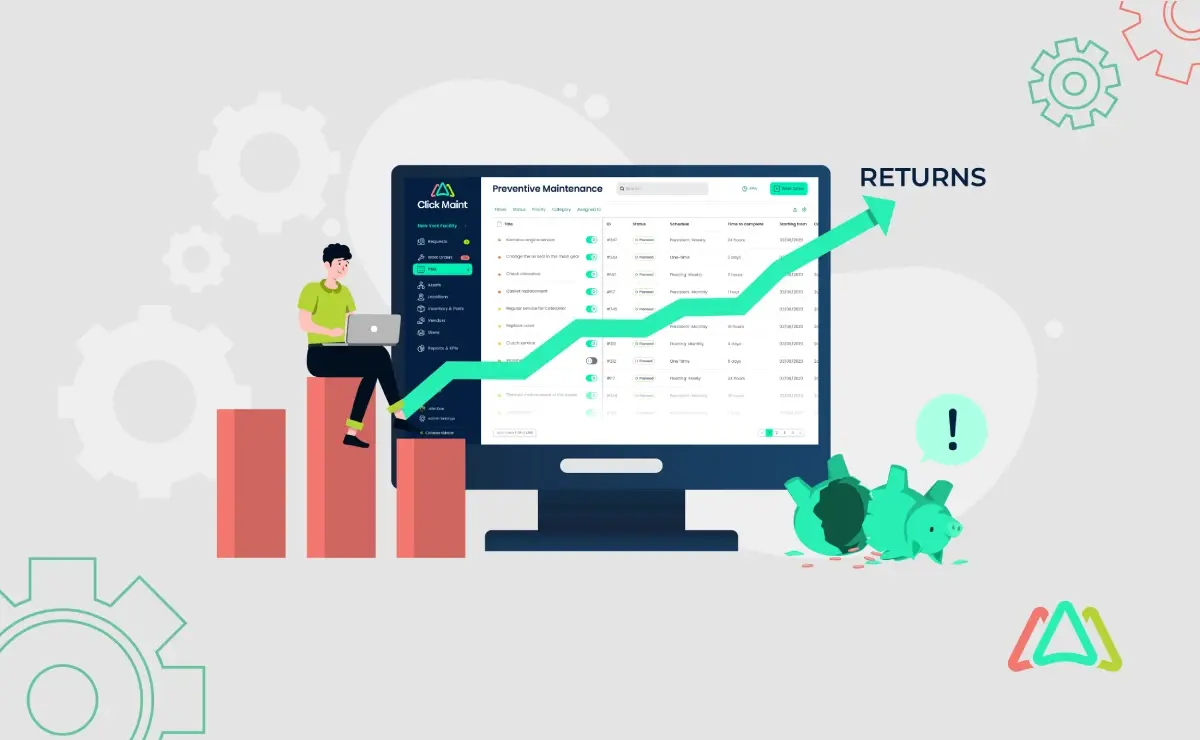
Investing in CMMS and Saving Money - The Ultimate Handbook
The importance of CMMS in preventive maintenance cannot be emphasized enough. By implementing CMMS software, companies can address maintenance issues before they escalate, reducing downtime and extending the lifespan of assets. This approach not only ensures smoother operations but also translates into substantial cost savings by minimizing unplanned repairs and disruptions. However, investing in CMMS can be challenging, especially when cash flow is tight.
This article provides practical tips for companies looking to invest in CMMS software while managing cash flow constraints. The following insights will help organizations make informed decisions and optimize their maintenance management processes when cash flow is tight.
Assessing Your Needs and Budget
When investing in CMMS software, conducting a thorough assessment of your needs and budget is essential. Start by identifying the primary features and functionalities your organization requires. Essential components might include preventive maintenance scheduling, work order management, asset tracking, and integration with existing business applications. Identifying these needs based on your maintenance management requirements ensures that the chosen CMMS software aligns with your operational goals. Setting a realistic budget is the next step. While CMMS can represent a significant investment, consider the long-term return on investment (ROI) of implementing the software. A well-chosen CMMS software can lead to significant cost savings by reducing downtime, extending the lifespan of assets, and minimizing emergency repairs. However, it’s important to balance these benefits with your current financial situation.
Evaluate the quality and capabilities of various CMMS software systems against their costs to find an optimal solution that meets both your needs and budget. This approach helps ensure that you invest in a software solution that delivers value without overextending your financial resources. By carefully assessing your needs and setting a realistic budget, you can make a well-informed decision that supports and optimizes your maintenance operations.
Choosing SaaS CMMS Over On-premise Solution
The initial costs of CMMS software may pose a financial challenge for companies when cash flow is tight. While traditional on-premises installation requires additional expenses for system maintenance and updates, the landscape has shifted with the advent of Software as a Service (SaaS) solutions. SaaS models typically include ongoing updates and system maintenance as part of the subscription, reducing the burden of extra costs for companies operating on limited financial resources. This shift towards SaaS not only addresses the immediate financial constraints faced by companies but also offers scalability and flexibility, allowing organizations to adjust their CMMS usage and subscription plans according to their evolving needs and financial status. In essence, by embracing SaaS CMMS solutions, companies can overcome financial barriers, streamline their maintenance operations, and ensure long-term sustainability and competitiveness in their respective industries.
Negotiating Contracts with CMMS Providers
When investing in CMMS software, effective negotiation is important when considering managing costs and optimizing cash flow. Begin by negotiating favorable payment terms with CMMS providers. Request for monthly or quarterly payments instead of annual to avoid large upfront costs and better align payments with your budget cycles. Also, consider the advantages of multi-year contracts, by committing to a longer term, you can often negotiate discounts, reducing the overall cost of the CMMS software. However, even with long-term commitments, insist on monthly or quarterly payments to manage cash flow better and maintain financial flexibility. Holding on to cash allows your company to gain interest from banks and avoid paying interest on borrowed funds.
Also, try to negotiate on termination clauses if you can. Ask for a termination for convenience clause. This clause allows you to cancel the contract if the CMMS software does not meet your needs. Many providers will push back on this so we advise that you emphasize your confidence in the CMMS provider's product and services. Explain that if their software truly delivers the benefits discussed, there should be no reason for early cancellation.
Timing Your Purchase for Maximum Savings
Planning when you buy and sign a contract can have significant cost savings.. Companies can often secure substantial savings by purchasing at the end of the month or quarter Timing your commitment wisely is essential, as vendors may be more willing to offer discounts or incentives to meet sales targets during these periods. End-of-year purchases are particularly beneficial, as many companies strive to meet annual revenue goals. Capitalizing on the vendor's urgency to finalize sales before the year-end, provides software buyers the opportunity to secure significant discounts and additional perks, maximizing savings on their CMMS investment that would normally not be available. By strategically timing your purchase, you can optimize your budget and achieve maximum value from your investment in preventive maintenance and facility management software. Keep these key periods in mind to capitalize on opportunities for substantial savings and enhanced ROI.
Capitalizing On The ROI (Return On Investment)
Capitalizing on the return on investment (ROI) of CMMS software can justify the investment and enhance cash flow management. By demonstrating the potential cost savings and efficiency gains achieved through preventive maintenance software, companies can build a compelling business case for the investment. Highlighting how CMMS software streamlines maintenance processes, reduce downtime, and extend asset lifespan can reassure business owners and stakeholders of the long-term value proposition. This approach not only strengthens the financial justification for CMMS investment but also aligns with strategic goals of optimizing facility management and preventive maintenance practices. By optimizing cash flow and showcasing the ROI of CMMS software, companies can make informed decisions that support their operational objectives while maintaining financial stability.
Leveraging Software Trials and Demos
To make informed decisions when investing in CMMS software, companies can benefit from leveraging software trials and demos. Many CMMS providers offer free trials or demos, allowing organizations to evaluate multiple options before making a commitment. During these trial periods, it's required to thoroughly assess whether the software meets your facility management needs, including features like preventive maintenance scheduling, work order management, and asset tracking. Moreover, trial periods can also be utilized to negotiate better terms with CMMS providers. By actively engaging with the software during the trial, companies can gather valuable feedback on its usability, functionality, and performance. This feedback can then be used to strengthen the negotiating position, highlighting specific areas where improvements or customizations may be necessary to align with your requirements. Software trials and demos empowers companies to make well-informed decisions about CMMS investments. By carefully evaluating options and using trial periods strategically, organizations can ensure they choose the most suitable CMMS software for their facility management needs while negotiating favorable terms that align with their budget and objectives.
Exploring Financing Options
Exploring financing options is essential when considering investments in CMMS software for preventive maintenance and facility management. Two common financing solutions to evaluate are leasing and purchasing CMMS software. Leasing offers the advantage of accessing advanced CMMS software without a substantial upfront payment. Instead, payments are spread out over a set period, providing flexibility and preserving capital for other operational needs. On the other hand, purchasing CMMS software provides long-term ownership after full payment, potentially resulting in cost savings over time, particularly for companies with stable financial resources and a clear roadmap for system utilization.
Additionally, companies can explore vendor financing options, where CMMS providers offer tailored financing plans to meet specific budgetary requirements. These plans often feature customizable payment terms and competitive interest rates, enhancing affordability and accessibility for businesses of all sizes. By spreading the cost of CMMS software over time through financing options, companies can implement effective preventive maintenance solutions while managing cash flow and preserving capital for other investments. This approach ensures organizations realize the benefits of CMMS software without straining their financial resources.
Conclusion
In conclusion, investing in CMMS software when the cash flow is tight requires careful consideration and strategic planning. Throughout this article, we have discussed key strategies to help companies navigate the challenges of acquiring CMMS software while managing financial constraints. Negotiation and strategic timing emerge as key components in the CMMS investment process. By negotiating favorable payment terms, leveraging end-of-month or end-of-quarter opportunities, and exploring financing options, companies can optimize their cash flow and maximize savings. These strategies enable organizations to obtain the necessary CMMS solutions while minimizing financial strain. It's also essential to recognize the long-term benefits of preventive maintenance software. By implementing CMMS software, companies can enhance facility management practices, streamline maintenance processes, and minimize downtime. These improvements not only drive operational efficiency but also result in significant cost savings over time.
Despite financial constraints, making a smart CMMS investment is achievable with the right approach. By prioritizing needs, setting realistic budgets, and exploring financing options, companies can align their investments with their operational goals and budgetary constraints. Also, leveraging software trials and demos allows for informed decision-making, ensuring that chosen CMMS software meets specific facility management requirements.
Investing in CMMS software is an investment in the future success of an organization. With careful planning and execution, even companies with tight cash flow can make intelligent CMMS investments that drive long-term savings and operational excellence.
TABLE OF CONTENTS
Keep Reading
Ever find yourself checking into a luxury hotel and expecting a relaxing stay, only to find a ...
11 Apr 2025
Organizations are witnessing swift changes in the business environment and confronting a ...
8 Apr 2025
Last month, news outlets and the entire internet was abuzz with the return of NASA astronauts ...
3 Apr 2025
What comes first - CMMS or predictive maintenance? If your answer is either, it is correct. ...
28 Mar 2025
Artificial intelligence (AI) talk has become commonplace. Today, engaging in business-focused ...
27 Mar 2025
Imagine a world where machines predict, diagnose, and fix their issues before they fail. This ...
25 Mar 2025
A facility maintenance plan is at the core of a facility’s operations. This organized ...
21 Mar 2025
Think of managing your maintenance operations like managing a championship sports team. Just ...
21 Mar 2025
The maintenance sector is battling a severe talent shortage that threatens to undermine ...
7 Mar 2025
Manufacturing maintenance is the backbone of industrial efficiency, ensuring machines run ...
5 Mar 2025
No one likes playing a guessing game when equipment breaks down. Yet, maintenance teams often ...
4 Mar 2025
The size of the preventive maintenance software market is discussed in millions of dollars, ...
4 Mar 2025
The organizational structure and corporate hierarchy vary from company to company. Large ...
28 Feb 2025
Maintenance procedures are essential for ensuring the longevity and reliability of machinery ...
21 Feb 2025
Sustainability is no longer just a buzzword; it's a critical component of corporate social ...
20 Feb 2025
A Computerized Maintenance Management System (CMMS) relies on accurate, well-organized data ...
18 Feb 2025
In an era where technology drives operational efficiency, Computerized Maintenance Management ...
14 Feb 2025
A Computerized Maintenance Management System (CMMS) is a key component of modern maintenance ...
13 Feb 2025
Introduction Maintenance management is the foundation of maintenance operations in industries ...
11 Feb 2025
Introduction A Computerized Maintenance Management System (CMMS) is software designed to help ...
7 Feb 2025





